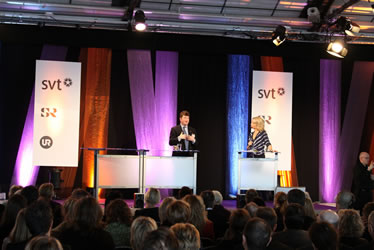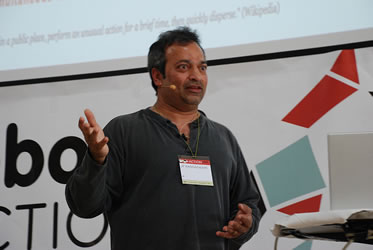
(Photo by US Embassy Sweden)
Before you start spending lots of time creating slides or shipping your props across the country for your speech, you need to do your technology homework first and know what the audience will be seeing when you’re on stage.
What does the backdrop look like? A simple black curtain with perhaps a slash of color, elaborate colored curtains, or perhaps even a built-up “set”? Your beautiful piece of artwork (or even choice of clothing) that you want to showcase on stage might simply disappear if the colors are too similar. Will there be a screen that images can be projected onto? Where is it located relative to where you’ll be talking?
How will the stage be lit? You might be squinting through bright lights (and unable to see your audience), or staring into a spotlight (that follows you around the stage), or perhaps the house lights will be up and little or no additional dramatic lighting will be added. The lighting affects not only how you look, but also how visible your slides and/or props will be. If you’re depending upon some dramatic lighting during your presentation, you need to give your show’s producer ample notice to see if your vision and their lighting abilities are a match.
How many people are likely to be in the audience? If there are hundreds (or thousands) of people, will the cute prop you’re bringing onstage be visible by more than the people in the first few rows? If not, will a camera be able to zoom in on what you’re holding and show it to your audience or recorded for later playback? If your personal goal is to have a great presentation for video for example, then it doesn’t matter if the audience can see your prop.

Photo by Miriam Olsson
Slides or not? For many presenters, it’s not a question – it’s an assumption that they’ll show their latest PowerPoint deck. From your audience’s perspective, why do they need to see the slide? Is it to show proof of what you’re talking about? Is it visual “eye candy” – something to break up the talk? Is it a requirement that they read along with what you’re saying?
If you do decide to use slides (and/or video), ensure that either: 1) you can bring your laptop (and associated cables) to connect to the projection system or 2) that your show producer has a version of the software that you used to create the slides on-site. If you’re going to use the producer’s software, then ensure that you have version compatibility (their software can read your files). Next, use slides that fit your audience size. The bigger the audience, the simpler the slides should be – since not everyone will be able to read the slide – just get a “gist” of what you’re trying to point out. But just because smaller audiences can read words on your slide, doesn’t give you permission to write down more than a few key thoughts. Be sure that if you use slides, you leave ample time to practice running your slides in the venue with show-like lighting. You might find that your slides don’t stand out nearly as well they did on your computer’s screen.
The microphone. Will your presentation be amplified? Will your presentation be recorded? If there is a microphone – will it be a handheld, on a stand, a lapel mic clipped to your shirt, or a headset mic that hooks on to your ear. Whatever the system, get comfortable with it so you’re not adjusting it during your talk. Also – if there is a microphone, don’t choose to ignore it. The audio might be vital for a video recording, and if you’ve wandered out of range, the video will suffer dramatically.
Remember that your speech is ultimately a live performance. You don’t want to add unnecessary complexity to your performance (that might be a distraction). But if you do choose to make things more complex, practice your presentation as much as your speech.